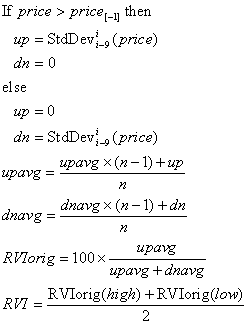Relative Volatility Index (RVI)
The Relative Volatility Index (RVI) is based on the Relative Strength Index (RSI). Whereas the RSI uses the average price change, the RVI uses a 9 period standard deviation of the price.
The RVI indicator is a revision of the original RVI. The original version of the RVI is calculated using the closing price. The revised version is calculated by taking the average of the original RVI of the high and the original RVI of the low. See Relative Volatility Index - Original Calculation for the original version.
The RVI is a volatility indicator. It was developed as a compliment to and a confirmation of momentum based indicators. When used to confirm other signals, only buy when the RVI is over 50 and only sell when the RVI is under 50. If a signal is ignored, buy when the RVI is over 60 and sell when the RVI is under 40. Exit a long position if the RVI drops below 40 and exit a short position when the RVI rises above 60.
The Relative Volatility Index was developed by Donald Dorsey and was originally introduced in his article in the June, 1993 issue of Technical Analysis of Stocks & Commodities magazine, and later revised in his article in the September, 1995 issue of the same magazine.
Formula:

Copyright © 2020, FM Labs, Inc.
